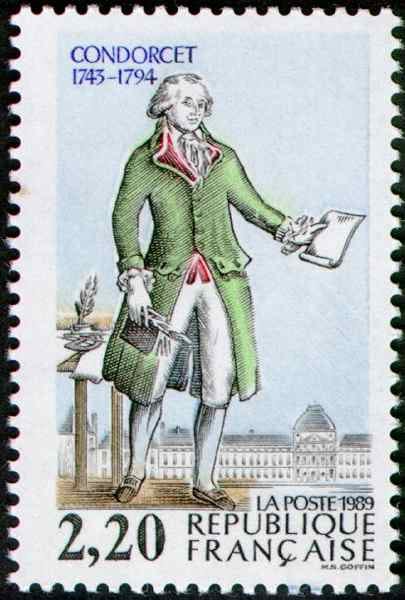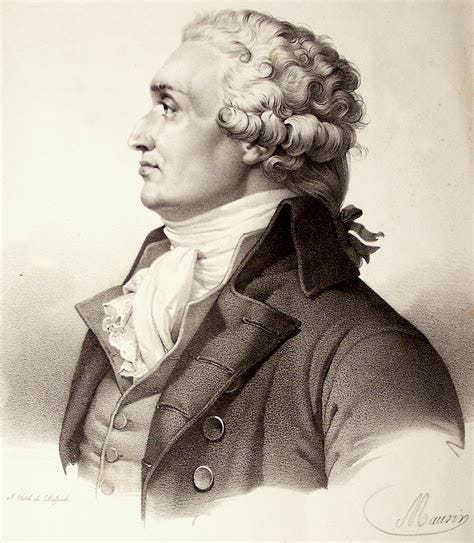The Condorcet Method
Or rather, methods.
One of the people who arguably founded the modern field of voting theory was Marie Jean Antoine Nicolas de Caritat, better known by his title of Marquis de Condorcet. He was a mathematician and political philosopher, whose more political work eventually brought his life to an untimely end in 1794.
Within the study of the mathematics of voting systems, he is best known for his discussion of pairwise majority votes - voting between two choices at a time. Pairwise votes are very often seen in committees. A candidate who wins every pairwise vote is called a Condorcet winner; a candidate who loses every pairwise vote is called a Condorcet loser.
It seems perfectly reasonable that Condorcet winners should generally place first in an election, while Condorcet losers should generally not place first in an election. Respectively, those are the Condorcet winner criterion and the Condorcet loser criterion. Alarmingly, a simple plurality vote violates both criteria. In fact, it turns out that very few voting systems fulfill both criteria. Those that do are known as Condorcet methods.
The two types of Condorcet methods
There are two basic categories of Condorcet methods: Methods that use a series of Borda counts (most famously Nanson’s method), and methods that compare candidates in pairs (most famously Dodgson’s method). There are many different ways to combine the results from multiple pairwise methods.
The most commonly used Condorcet method is a sequential pairwise vote. Committees commonly use a series of majority votes between one pair of options at a time in order to decide between large numbers of possible choices, eliminating one candidate with each vote. If a Condorcet winner exists, then they will emerge the winner of this sequence of majority votes; if a Condorcet loser exists, then they will be removed from consideration after a single vote.

The problem with sequential pairwise voting is that if a Condorcet winner does not exist, then the winner is determined by the order of the agenda - it is a method that does not treat all candidates equally. Since a Condorcet paradox can involve large margins of victory, it can be hard to determine if a Condorcet paradox is present based on a single-elimination sequence of majority votes.
The Borda-based Condorcet methods
In a Borda count, lower place votes are worth less than a full first place vote. With five candidates, for example, a second place vote is worth 3/4 of a first place vote, a third place vote is worth 1/2 of a first place vote, and a fourth place vote is worth 1/4 of a first place vote.
The series of Borda counts in Condorcet methods like Nanson’s method works similarly to the family of methods known today as ranked choice voting: Ballots are tallied, candidates are eliminated, and then the ballots are recounted using the smaller number of candidates. Rather than eliminating a single candidate at a time (a method known as Baldwin’s method or Total Vote Runoff), Nanson’s method, described in 1882 by Edward Nanson, efficiently eliminates all candidates with below-average vote totals at the same time, reducing the number of times the ballots need to be recounted.
The reason this works is that in a Borda count, a Condorcet winner will have a higher than average total, while a Condorcet loser will have a lower than average total. Thus, if only candidates with below average totals are iteratively eliminated in each round of counting, a Condorcet winner will never be eliminated.
One major advantage of Nanson’s method is that in terms of ballot tabulation, it is the most efficient Condorcet method. For example, with eight candidates on the ballot, the election will most likely be resolved by counting ballots three times. Even a simple sequential pairwise vote would require seven tallies.
The more complex Condorcet methods.
The more complex Condorcet methods require looking at the tallies for every pair of candidates, checking if a Condorcet winner exists, and then optionally performing calculations based on those tallies. For eight candidates, this requires computing twenty-eight pairwise tallies. Every obvious way of combining those tallies has then been considered:
Taking the candidate whose worst margin is the least bad gives the Minimax method.
Taking the candidate who wins the largest number of pairwise victories gives Copeland’s method or Llull’s method.
Taking the candidate with the largest combined margin from all pairwise contests gives Black’s method. (Provided that all ballots are filled out completely; Black’s method specifies using a Borda count as a tiebreaker.)
Then there are less obvious ways to figure out which candidate is closest to being a Condorcet winner, requiring more complex manipulations of either the pairwise tallies or the ballots themselves. One such complex method was invented by Charles Dodgson, better known for his 1865 book Alice’s Adventures in Wonderland (written a pen name, Lewis Carroll).

Dodgson’s method examines all pairwise tallies to check, first, if a Condorcet winner exists. If a Condorcet winner does not exist, then the next step is to try to determine which candidate is closest to being a Condorcet winner. This is determined by counting how many times one would need to swap pairs of candidates on individual ballots. The candidate requiring the fewest swaps to reach Condorcet winner status wins.
Another highly complex Condorcet method is the Schulze method, which has gained some traction in the open source community. This method uses the pairwise tallies to construct a directed graph, and then performs an evaluation of the paths within that directed graph.
Condorcet methods in summary
The Condorcet methods are a family of related voting systems that all pay respect to the idea that a candidate who would be able to win all head-to-head contests should also win a multi-candidate election. Because the number of possible pairwise contests grows quickly as the number of candidates grows, determining whether or not a Condorcet winner exists is not a simple task.
There’s also no clear way to generalize the idea of a Condorcet winner to situations where there is a Condorcet paradox. This, in turn, means that there are a large number of different Condorcet methods, notably:
A sequential pairwise elimination vote, which doesn’t treat early candidates as fairly as later candidates. If no Condorcet winner exists, the results are determined by the order of the agenda instead of by the virtues of any particular choice.
Nanson’s method and similar sequences of Borda counts that score ranked ballots multiple times.
Methods that start by comparing all possible pairs of candidates using a set of ranked ballots, and then use either a simple or complex tie-breaking procedure if no Condorcet winner exists.
The overall complexity of Condorcet methods tends to make it difficult to advocate for their adoption in large-scale elections, as opposed to being used by committees or smaller working groups. Electing a Condorcet winner may be desirable, but it is takes a significant amount of information to identify a Condorcet winner. To the best of my knowledge, the only uses of a Condorcet method in political elections in the wild were the use of Nanson’s method in municipal elections in Marquette, Michigan about a century ago.


